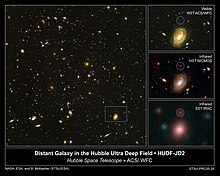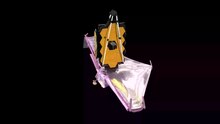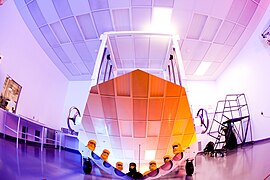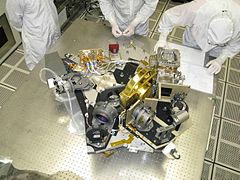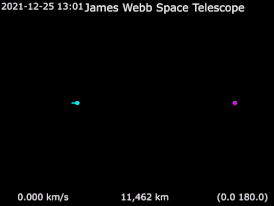James Webb Space Telescope
| James Webb Space Telescope | ||||||||||||||||||||||
|---|---|---|---|---|---|---|---|---|---|---|---|---|---|---|---|---|---|---|---|---|---|---|
 Top of the James Webb Space Telescope |
||||||||||||||||||||||
| NSSDC ID | 2021-130A | |||||||||||||||||||||
| Mission objective | L 2 orbit | |||||||||||||||||||||
| operator |
|
|||||||||||||||||||||
| Launcher | Ariane 5 ECA + (Flight VA256) | |||||||||||||||||||||
| construction | ||||||||||||||||||||||
| Takeoff mass | 6350 kg | |||||||||||||||||||||
| Instruments | ||||||||||||||||||||||
|
NIRCam; MIRI ; NIRSpec; FGS / NIRISS |
||||||||||||||||||||||
| Course of the mission | ||||||||||||||||||||||
| Start date | December 25, 2021, 12:20 UTC | |||||||||||||||||||||
| launch pad | Center Spatial Guyanais , ELA-3 | |||||||||||||||||||||
|
||||||||||||||||||||||
The James Webb Space Telescope (English: James Webb Space Telescope , abbreviated JWST or Webb ) is a space telescope as a joint project of the space agencies NASA , ESA and CSA , which, after years of delays, was launched on December 25, 2021 with an Ariane 5 launcher was started to the target point.
The JWST will fly to the Earth and Sun Lagrange point L 2, approximately 1.5 million kilometers from Earth, and operate in orbit around this point. The telescope was initially planned under the name Next Generation Space Telescope , until it was decided in 2002 to name it after the former NASA administrator James Edwin Webb . It can be seen as the scientific successor to the Hubble telescope . While Hubble works in the visible , near ultraviolet and near infrared spectrum , JWST specializes in infrared astronomy ; thus it is also the successor to the Spitzer space telescope .
tasks
The JWST has four main scientific tasks:
- The search for the first luminous objects and galaxies that arose after the Big Bang and the dark ages that followed, 13.5 billion years ago.
- Improvement of the understanding of the structure formation processes in the universe.
- The investigation of the formation - and further development - of galaxies, black holes, stars and planetary systems , in particular the exploration of protoplanetary disks .
- Investigation of exoplanets , their atmosphere and possible suitability for life.
The JWST is sometimes 100 times more sensitive to electromagnetic waves than the Hubble telescope. The technical precision enables the JWST to reveal hidden areas of the solar system, to look inside star formation areas and to analyze the chemical composition of the atmospheres of exoplanets in more detail.
The JWST examines wavelengths from 0.6 to 28 µm , that is, from visible red light to the mid- infrared . Light from distant and thus also early regions of the universe is shifted into this area by the cosmological redshift . Infrared is also emitted by cool objects and can penetrate interstellar gas clouds better than visible light. The project is planned for a period of five years, the fuel supply is sufficient for an extension of the scientific operation to ten years.
Start date, financing and preparations
The development of the James Webb Space Telescope began in 1996, the telescope was originally supposed to be launched in 2007. Later, a launch in 2014 with an Ariane 5 was planned. The necessary 3.3 billion euros for the construction and ten-year operation were initially secured on the US side. However, due to the enormous increase in costs, the Science Committee of the US House of Representatives recommended on July 13, 2011 that construction of the telescope be stopped. The construction costs were estimated by NASA at the time at 8.7 billion US dollars. By then, about $ 3 billion had been spent and about 75% of the necessary components had been purchased, including most of the scientific instruments. All elements of the primary mirror were also completed. In December 2014, the financing including operating costs for the first five years was considered secured again, and a start was not expected until 2018 at the earliest.
Finishing began in November 2015. The 18 segments of the primary mirror had been installed by the beginning of February 2016. In November 2016, the first measurements of the optical properties were carried out on the mirror. On December 18, 2015, the supply contract for the Ariane 5 rocket was signed. The flight was initially planned for spring 2019 and was then postponed to May 2020 at the earliest after various quality defects had been identified. Among other things, there were problems with the steering engines and with the deployment of the sun shield. Foils of the sun shield were torn several times. During a vibration test, screws and washers fell out of the telescope. Further postponements followed, among other things because a clamping band was loose after the transport to the spaceport and because of unsuitable weather conditions.
In 2018, the total cost of the mission was estimated at $ 9.66 billion, including $ 8.8 billion in development costs. By December 2021, the cost reached $ 9.7 billion. This makes it the most expensive scientific project in unmanned space travel . ESA is directly involved in the JWST with around 300 million euros. This includes the launch with an Ariane 5 rocket, the NIRSpec instrument, the optical bench for the MIRI instrument and staff ( astronomers of the ESA) in the scientific mission center ( Space Telescope Science Institute ) in Baltimore , USA. Overall, the ESA expects its own share to incur costs in the context of an M-Class mission.
In the summer of 2021, the telescope in Long Beach was subjected to final tests at the defense and space company Northrop Grumman and then packed for transport in a special container, which represents a transportable clean room. At the end of September 2021, it was loaded onto the ship MN Colibri , which then left for the Guiana Space Center . It was taken into account that pirates could kidnap the ship in order to extort ransom. Because of this, the details about the transport were not disseminated in the media. Air transport was not an option due to the lack of infrastructure in French Guiana , and the bridges between the airport and the launch base were not designed for such heavy transport. On October 12th, the telescope arrived in a special transport at the port of Pariacabo near Kourou.
Planned course of the mission
Start and flight to the place of use
The launch of the Ariane-5 - launch vehicle took place on December 25, 2021 at 12:20 UTC from the Guiana Space Center in French Guiana . The payload fairing of the Ariane rocket was modified for the telescope because potentially harmful vibrations had been measured during previous missile launches. The payload fairing now had 28 vents to ensure pressure equalization during the launch sequence. The total mass of the telescope at take-off, including fuel, was around 6.2 tons. The telescope was folded up for transport in the rocket and will unfold itself in many sub-steps while it is on the way to the observation orbit. The center of gravity of the collapsed telescope was not on the missile's axis of rotation ; ballast had to be carried to compensate .

Both rocket stages brought the telescope on speed and course to the Lagrange point L 2 of the earth and the sun, 1.5 million kilometers away . After disconnecting the main stage within the first 10 minutes after take-off, the telescope was at the cryogenic ESC-A upper stage for another 17 minutes before it was also detached from it. From launch to separation from the launcher, the French space agency CNES tracked the Ariane 5 from ground stations in Kourou, Ascension Island (in the South Atlantic), Natal (Brazil), Libreville (Gabon) and Malindi (Kenya). Immediately after the separation of the JWST from the ESC-A upper stage of the Ariane 5, ESTRACK , the ESA's tracking ground station network , took over and followed the JWST through the early orbit phase. The ESA ground station in Malindi (Kenya) and the NASA station network were used for this. 31 minutes after the start, the solar panels opened to provide energy. 12 hours after take-off from Earth, the JWST fired the engine , which set it in motion in the direction of Lagrange point L 2 ; JWST will aim at L 2 is within a 30 day continuous flight. After one day the high gain antenna was extended.
After 2.7 days, the two main beams for the awning should first be unfolded. In order to protect JWST from instability due to the solar wind after the main girders have extended, trim tabs on the main girders of the awning are extended. On the fourth day, the telescope should be lifted in order to thermally shield it from the other parts such as the drive and supply unit. After six to seven days, the protective covers for the foils should be opened and the two telescopic side masts should be pushed out in order to unfold the sunshade. Next, the foils should be tightened and separated so that a space is created between each layer so that heat radiation can be released into the environment. The complicated unfolding of the sun shield is said to last until about the tenth day; then the secondary mirror can be folded out and the cooling elements of the instruments extended. By the thirteenth day, the side parts of the main mirror should be folded out into the end position, thus completing the unfolding.
In the period up to the 23rd day, the instruments should cool down enough that they can start their function for the first tests. On day 29 to JWST, which has a locomotive and control unit, make a course correction to return to its orbit around L 2 to swing. The mirrors should then be precisely aligned. Six months of preparation time are set for the uniform cooling of all components down to operating temperature, the function tests, the calibration of the instruments and the fine adjustment of the mirrors; then the first scientific data are expected.
Orbit
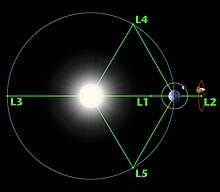
The telescope is to be put into orbit around the Lagrange point L 2 in the earth-sun system, about 1.5 million km above the night side of the earth. As a result, the disruptive infrared radiation from the sun, earth and moon can be shielded together by the radiation shield and, unlike in low earth orbit, long uninterrupted exposure and observation times are possible. A positive side effect of this orbit is that the telescope is hardly at risk of being hit by space debris.
Different orbits around L 2 are possible, torus, halo or Lissajous orbits , which have in common that the probe does not enter the shadow of the earth or the moon in order to guarantee the power supply. The actual orbit is only selected after the start, depending on the start window within the synodic month .
Orbits around L 2 are not stable, which is why the orbit has to be corrected again and again by rocket engines . One cycle takes about 6 months, with corrections being made every 21 days. The fuel carried should last for about ten years. This is the only aspect of the design that severely limits the mission duration. However, there is a device for refueling that would allow a subsequent replenishment of the fuel supplies by a robotic mission. The main mission lasts five years, an extension is foreseen, subject to funding. A disadvantage of the positioning of the telescope around the L 2 point is the great distance to earth compared to, for example, the Hubble telescope , which makes the use of the deep space network necessary for communication.
operation
At least 300 mechanisms must have worked by the time it goes into operation, of which - depending on the definition - between 144 and 178 are due to the deployment of the JWST. These mechanisms can be summarized in 59 “critical processes” on which the success of the mission depends. Defective parts of the telescope cannot be repaired.
To ensure that the observations are not disturbed by the infrared radiation (heat radiation) of the telescope and the instruments themselves, all parts of the telescope must be kept permanently below 50 Kelvin (−223 ° C) and, in particular, protected from solar radiation . For this purpose, the JWST has a 21.2 m × 14.2 m, multi-layer foil screen that shields the telescope from the sun, moon and earth. The MIRI (Mid Infrared Instrument) is actively cooled in order to reach a temperature of below 15 K (−258 ° C).
construction
The entire system consists of three main components: the supply unit, the sunshield and the payload consisting of the telescope and the instruments.
SpaceWire is used to transfer data between the main components .
Supply unit
The supply unit (official name: Spacecraft Bus ) provides the technology for the basic functions for operating the probe. It is housed in a box made of carbon fiber composite material. The basic functions are:
electric energy supply
The probe has solar modules with an output of 2000 W over the mission time and accumulators for power supply on the hot side.
Position control
The probe is three-axis stabilized and has sun sensors, three star sensors , gyroscopes, six reaction wheels and control nozzles for position control. The star sensors have a field of view of around 16 ° and a 512 × 512 pixel sensor. They are arranged at an angle of 45 ° to the telescope axis and against each other. The observed stars with a magnitude of up to 6 are compared with a stored star map and the spatial orientation is recognized. The alignment of the telescope axis is done by aligning the entire probe. The alignment of the telescope axis based on the position control is in the range of 8 "before a guide star is detected and the fine adjustment is used. The fine adjustment, which is made possible by a movable mirror, is part of the telescope and the instruments and not part of the position control.
Communication system
Two omnidirectional omnidirectional antennas with hemispherical characteristics in the S-band for telemetry , command transmission and satellite laser ranging are used to determine the distance and position. Communication via these antennas can take place at any time and in any spatial position, as long as there is visual contact with a ground station. The possible data rate is sufficient for simple control commands, but is not sufficient to transfer data of the payload.
An antenna with a diameter of 20 cm, which is mounted in the same direction as the main parabolic antenna, is used for data transmission at up to 40 kbit / s in the S-band. The data rate in the downlink (2.2… 2.3 GHz, transmission power 6 watts) for telemetry can be between 0.2 and 40 kbit / s and in the uplink (2.025… 2.12 GHz) for commands 2 to 16 kbit / s . The S-band is used during the set-up time and in the work phase; it is also used for emergency communication. In contrast to the Ka-band , the transmission of data at this frequency is hardly affected by bad weather.
For the transmission of scientific data, the JWST has a movable 60 cm parabolic antenna for communication in the Ka-band (26 GHz). This antenna can be directed towards earth from any position, even during observations. The antenna has to be realigned approximately every 2 hours and 45 minutes, so this is the maximum integration time for observations during data transmission and for special tasks that require simultaneous data transmission during the observation time. The transmission is optionally possible with a data rate of 7, 14 or 28 Mbit / s. The highest data rate is normally used, but it can be reduced if bad weather conditions prevail at the receiving station. There is a four-hour data transfer phase every twelve hours. Each four-hour contact can transmit at least 28.6 GB of data during normal operation. The three antenna stations of the Deep Space Network in Goldstone, Canberra and Madrid are planned for the downlink .
Control system
The control system consists of the on-board computer and a solid-state drive . This memory has a capacity of 58.9 GB, is designed for the amount of data accumulating in 24 hours and contains both the scientific data and the data from the supply unit.
Propulsion and fuel tanks
The fuel is designed for at least ten years of operation plus half a year of preparation time. There are two types of drives that are attached to the supply unit:
- Two pairs of Secondary Combustion Augmented Thrusters (SCAT) are used for pivoting and regular path correction at the L 2 point. One of the engines in each pair is redundant. The engines use hydrazine (N 2 H 4 ) and dinitrogen tetroxide (N 2 O 4 ) as oxidizers. The task of a helium tank is to put both components under pressure.
- Eight mono-propellant rocket engines (MRE-1) enable the position control and the desaturation of the reaction wheels: the solar wind causes a moment because the glider is asymmetrical to the center of gravity, so it can happen that the reaction wheels can no longer compensate for a moment in order not to to work beyond their specifications. These engines only use hydrazine as fuel.
Thermoregulation
The supply unit is on the hot side and is operated at a temperature of around 300 K or 27 ° C. There are radiators for heat dissipation . The payload instruments have their own radiators on the back of the main mirror.
Sun shield
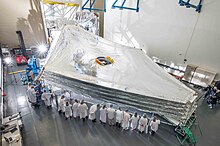
The sun shield has the task of keeping infrared or thermal radiation away from the telescope and the instruments. This sun shield consists of five layers of Kapton , a polyimide coated with aluminum and doped silicon . Five layers of Kapton foil not only separate the telescope from solar radiation, but also from the supply unit and its electronics, which must have a certain minimum temperature in order to work reliably. The temperature difference between the side facing the sun at approx. 358 K (85 ° C) and the side facing away from the sun at approx. 40 K (−233 ° C) is over 300 K. A complicated mechanism secures the foils during take-off and ensures that they are correct Development on the way to the goal.
The layers are each about one to two thousandths of an inch (25 or 50 μm) thin.
optics
The JWST is constructed as a Korsch telescope (TMA - Three-Mirror-Anastigmat). The effective focal length is 131.4 meters.
The main mirror has a diameter of 6.5 meters and consists of 18 hexagonal segments that only unfold in space. The mirrors are made of beryllium , which was chosen mainly because of its low density, its high strength and its low coefficient of thermal expansion below 100 K. The mirrors were examined for the impact of micrometeorites. The surface weight of the beryllium plates is 10.3 kg / m², including the mirror mounting 15.6 kg / m². The individual segments can be precisely aligned with actuators . Each segment has an inscribed diameter of 1.3 meters, with a mass of 20 kilograms. They were made by Ball Aerospace in Boulder (Colorado) . The last plate left production on February 7, 2007 to be ground and polished. The primary, secondary and tertiary mirrors were vapor-coated with gold, which also reflects very well in the infrared range.
The convex secondary mirror (secondary mirror) can be aligned in six degrees of freedom and is attached to a foldable support structure. The light is directed to the instruments in the image plane via the tertiary mirror and a fine alignment mirror .
Instruments
The instruments that are important for scientific observations are located in the Integrated Science Instrument Module (ISIM) .
- NIRCam ( Near Infrared Camera ) ( near infrared spectroscopy ) is a NASA project and detects light or infrared radiation with a wavelength between 0.6 and 5 µm ( near infrared ) using mercury-cadmium-telluride sensors. It captures light from the first stars and galaxies that formed after the Big Bang and is intended to investigate them more closely. The camera's field of view consists of two squares of 2.3 '× 2.3' ( arc minutes ) each , one of which detects radiation with a wavelength smaller and the other larger than 2.5 µm. The angular resolution is 0.034 "or 0.068" ( arc seconds ). NIRCam is operated passively cooled at a temperature of less than 50 Kelvin. The instrument was provided by the University of Arizona under the direction of Marcia J. Rieke .
- MIRI ( Mid Infrared Instrument ) observes cold, distant objects in the mid infrared range (wavelengths between 5 and 28.3 µm). It consists of a camera with three identical 1024 × 1024 pixel detectors and a spectrograph for spectroscopic mapping . The angular resolution is approx. 0.19 ″. MIRI is actively cooled with a cryocooler (helium cycle) to a temperature of 6 Kelvin. MIRI is based on a collaboration between ESA, a consortium of government-funded European institutes and NASA's Jet Propulsion Laboratory and Goddard Space Flight Center . The use of MIRI is split between 50% ESA and 50% NASA.
- NIRSpec ( Near Infrared Spectrograph ) is a spectrograph for the wavelength range from 0.6 to 5 µm. It can record spectra of 200 objects at the same time and, like MIRI, is able to perform spectroscopic mapping. It shares with NIRISS the ability to record the mass, temperature and chemical composition of objects. It was developed and manufactured by Astrium on behalf of ESA , which in turn commissioned Carl Zeiss Optronics GmbH to do this.
- FGS-NIRISS ( Fine Guidance System / Near-InfraRed Imager and Slitless Spectrograph ). NIRISS is a slotless spectrograph with a wide field of view (2.2 '× 2.2') for the wave range 1.0 µm - 2.5 µm. The instrument has an observation mode that is optimized for spectroscopy of exoplanets (detection of molecules in atmospheres). It measures the mass, temperature and chemical composition of objects. The Fine Guidance System is used to precisely align the instruments and was developed in Canada . The project is led by the Canadian Space Agency (CSA) . Other participants are the Herzberg Institute of Astrophysics , the National Research Council of Canada and the University of Montreal .
NIRCam and MIRI have starlight-blocking coronographs for observing weakly luminous targets, such as extrasolar planets and circumstellar disks , in the immediate vicinity of bright stars.
cooperation

|
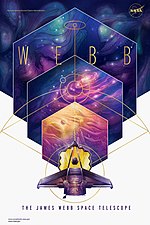
|
| Logo of the JWST | Webb Mission Poster |
Participants in alphabetical order:
NASA, ESA and CSA have been cooperating on the new space telescope project since 1996. The share of ESA involvement in both construction and commissioning was confirmed by the Member States in 2003; In 2007, an official agreement was made between NASA and ESA on this. In exchange for a full partnership as well as representation and access of their astronomers to the observatory, the ESA provides the NIRSpec, the optical bench of the MIRI, the rocket launch by the Ariane-5 ECA and 15 employees of the ESA for the operation in the scientific mission center. The Canadian CSA provides the fine guidance sensor and the near infrared imager slitless spectrograph as well as personnel to operate the telescope. By helping to make the mission possible, the ESA astronomers have a minimum share of 15% of the observation time with the James Webb Space Telescope.
For the first observation cycle with over 6000 hours of observation time available, 1172 applications from 44 countries were examined. This share corresponds to two thirds of the total observation time, the remaining third has already been assigned to the Early Release Science and Guaranteed Time (GTO) program. The projects are selected by an international committee of astronomers in several working groups, which select the most interesting of them. ESA has a say in these committees and scientists from the ESA states are represented in all committees. Of the 266 selected projects, 33% come from ESA member states, which account for 30% of the observation time. Of the selected projects, 41% will primarily use the NIRSpec and 28% the MIRI instrument.
gallery
Model of the NIRSpec ( NIR spectroscopy ) of the James Webb Space Telescope
Reflector components during a cryogenic test at the Marshall Space Flight Center
mounted primary mirror in the Goddard Space Flight Center
The ISIM module (in which the instruments important for research are located) during a gravity test
Test object of the NIRCam. Collimation lenses can be seen in the picture
Size comparison JWST and Hubble (animation)
See also
Web links
- Website (https://webbtelescope.org/) (English)
- Current status of NASA's JWST (Where ist the JWST now )
- JWST page of the NASA (English)
- JWST side of ESA (English)
- JWST page of the STScI (English)
- JWST page of the CSA / ASC (English)
Individual evidence
- ^ James Webb Space Telescope Facts . Retrieved December 8, 2021
- ^ A b Sarah Loff: James Webb Space Telescope Launch Update. December 21, 2021, accessed December 21, 2021 .
- ↑ Andreas Wilkens: James Webb Space Telescope is scheduled to start in mid-December. In: heise online. September 8, 2021, accessed September 9, 2021 .
- ↑ a b c d e f g h i j k l m ESA press kit for the James Webb Space Telescope
- ↑ a b c d e f g The James Webb Space Telescope. NASA , accessed May 13, 2012 .
- ↑ ABOUT JWST. In: jwst.nasa.gov. Retrieved April 27, 2010 .
- ↑ cris: $ 8.7 billion In: Süddeutsche Zeitung. Munich, August 24, 2011, p. 16.
- ↑ James Webb saved for the time being . Deutschlandfunk. April 27, 2012. Retrieved September 28, 2012.
- ↑ Martin Holland: Hubble successor: NASA begins finishing the James Webb space telescope. heise.de , November 30, 2015, accessed on November 29, 2016 .
- ↑ NASA's James Webb Space Telescope Primary Mirror Fully Assembled. NASA, February 4, 2016, accessed February 11, 2016 .
- ↑ NASA Completes Webb Telescope Center of Curvature Pre-test. NASA , November 2, 2016, accessed November 29, 2016 .
- ↑ NASA's James Webb Space Telescope to be Launched Spring 2019. NASA , September 28, 2017, accessed October 1, 2017 .
- ↑ Jeff Foust: NASA delays JWST launch to 2020. In: Spacenews. March 27, 2018. Retrieved May 9, 2018 .
- ↑ Stephen Clark: JWST occupied by another problem as Northrop Grumman revamps training. May 8, 2018. Retrieved May 9, 2018 .
- ^ A b Johann Grolle, Christoph Seidler: (S +) "James Webb" telescope: "You can only do something like this once in a generation" . In: The mirror . December 23, 2021, ISSN 2195-1349 ( spiegel.de [accessed December 24, 2021]).
- ^ "Hubble" successor "James Webb" space telescope: A folding mirror in space . In: The mirror . December 21, 2021, ISSN 2195-1349 ( spiegel.de [accessed December 21, 2021]).
- ↑ NASA Completes Webb Telescope Review, Commits to Launch in Early 2021. June 27, 2018, accessed June 28, 2018 .
- ↑ Stephen Clark: NASA delays launch of Webb telescope to no earlier than Dec. 24 - Spaceflight Now. Retrieved December 18, 2021 (American English).
- ↑ a b Dirk Asendorpf: The 10 billion dollar experiment at www.zeit.de , June 1, 2021, print June 2, 2021, edited June 6, 2021. Chargeable.
- ↑ a b c European agreement on James Webb Space Telescope's Mid-Infrared Instrument (MIRI) signed. Retrieved October 3, 2020 .
- ↑ a b Christoph Seidler: "James Webb": Could pirates steal the most expensive observatory of all time? In: The mirror . October 2, 2021 ( spiegel.de [accessed October 2, 2021]).
- ↑ ESA welcomes Webb in French Guiana for launch on Ariane 5. Accessed October 13, 2021 .
- ↑ a b c d e Thaddeus Cesari: The Road to Launch and Beyond for NASA's James Webb Space Telescope. November 2, 2021, accessed December 21, 2021 .
- ^ James Webb Space Telescope. Retrieved December 26, 2021 (American English).
- ↑ Deployment Explorer Webb / NASA. Accessed December 26, 2021 .
- ↑ Hubble Space Telescope: Webb Telescope Deployment Sequence. June 30, 2016. Retrieved April 21, 2017 .
- ↑ JWST Orbit. James Webb Space Telescope User Documentation, May 30, 2017.
- ↑ Chelsea Gohd published: There are over 300 ways that the new James Webb Space Telescope could fail, NASA says. November 3, 2021, accessed December 21, 2021 .
- ↑ Jason Townsend: GSFC: NASA - NASA's James Webb Space Telescope Gets 'Spacewired'. Accessed December 20, 2021 .
- ↑ JWST - eoPortal Directory - Satellite Missions. Retrieved April 6, 2021 (American English).
- ↑ JWST Spacecraft Bus - JWST User Documentation. Retrieved April 14, 2021 .
- ↑ JWST Attitude Control Subsystem - JWST User Documentation. Retrieved April 15, 2021 .
- ↑ a b JWST Communications Subsystem - JWST User Documentation. Retrieved April 14, 2021 .
- ↑ a b JWST Propulsion - JWST User Documentation. Retrieved April 14, 2021 .
- ↑ Webb Orbit. In: jwst.nasa.gov. Retrieved September 20, 2018 .
- ↑ Marcia J. Rieke Biography Webb Telescope / NASA. Accessed December 20, 2021 .
- ^ ESA Science & Technology - NIRSpec - the Near-Infrared Spectrograph on JWST. Retrieved December 20, 2021 .
- ↑ Mid-Infrared Instrument (MIRI) Instrument Webb / NASA. Accessed December 20, 2021 .
- ↑ ESA Science & Technology: Europe's Contributions to the JWST Mission
- ↑ Canadian Space Agency "Eyes" Hubble's Successor: Canada Delivers its Contribution to the World's Most Powerful Space Telescope ( Memento April 12, 2013 in the Internet Archive ), Canadian Space Agency, July 30, 2012
- ^ ESA Science & Technology - Selection of the first James Webb Space Telescope General Observer Scientific Programs. Retrieved April 4, 2021 .
